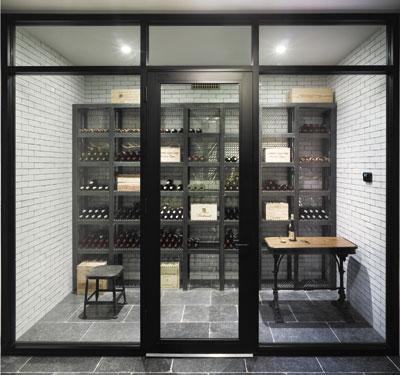Lower Level? Just Don’t Call It a Basement

The basement in the residence of Joe Farrell, the ubiquitous South Fork builder, is famously over the top. The 31,000-square-foot Bridgehampton house, which is said to have been rented by the likes of Madonna, Jay-Z, and Beyonce, boasts a 10,000-square-foot basement sporting a media room, gym, spa, racquetball-squash-basketball court, and two-lane bowling alley replete with pizza oven, bar, and seating.
There is also an “air lounge,” which the builder has said is the most expensive room in the house. This area, built for Mr. Farrell’s three children, includes a rock-climbing wall, half-pipe skateboard ramp, karaoke center with D.J. booth, golf simulator (allowing players to “play” courses worldwide), and a stage. For impromptu Shakespearean skits, perhaps?
When he built the house in 2009, people oohed and aahed, but these days blinged-out basements are par for the course. “Don’t use the B word,” said Gene Stilwell, an agent at Town and Country Real Estate who specified the preferred real estate term: “lower level.”
It does seem odd to refer to these subterranean palaces as basements, considering that they are often as kitted out as excessively as their upstairs neighbors.
John Kean, a builder, is about to break ground on a 20,000-square-foot house on Huntting Lane in East Hampton Village that will contain two bowling alleys, movie theater, wine cellar, billiards and Ping-Pong area with bar, and a couple of en suite bedrooms and that open up to outside. And an elevator to lift you out of the depths.
“I think it’s necessary in the high end in the Hamptons,” Mr. Kean said. “People are coming out for their vacation, bringing kids, grandkids, friends, and looking for all the amenities.”
In a land with stringent height and footprint restrictions, basements essentially give their houses a third floor. “Despite all the downsizing talk, bigger is better for Wall Street,” said Leslie Reingold, an agent with Sotheby’s International Realty. This holds true even on small lots, she said. Considering the trend toward moving into the “stimulation” of villages, homeowners still want the perks of larger houses. Thus underground expansion.
“Almost every house I have has a finished basement,” Chris Burnside of Brown Harris Stevens said of the properties he has listed. “It’s a standard now. If you’re building a new house it’s expected to have a movie theater, wine cellar, rec room, media room. If not, people won’t even look at the house.”
And it’s a financial boon for builders who, because the infrastructure is already in place, have found a cost-effective way to provide more living space. “It costs about half as much to build,” Mr. Burnside said.
Indeed, just about every spec house on the market has a finished basement. Priscilla Garston of Douglas Elliman Real Estate has a listing for a relatively small house, 3,500 square feet, in Bridgehampton asking $1.89 million. Its basement has a living room with a fireplace and French doors that lead into a courtyard, “making it feel like a ground floor.” It also has a laundry room and bedroom.
On Further Lane in East Hampton Village, Dan Scotti, a high-end builder, is marketing a house for just under $13 million that he has staged exquisitely with furnishings he has picked up in his travels. The basement is no exception. In the wine cellar, he designed shelving made of perforated industrial steel and had it fabricated onsite. Instead of a typical wine-racking grid, he used larger cubbies where bottles are stacked on top of one another. “It just feels less suburban to me.” For added “texture and drama,” he installed stone floors, and sheathed the walls in glazed brick. “I could have used Sheetrock,” he said, but that wouldn’t fit with his meticulous attention to detail. For the window he used a glass storefront, the better to ogle the wine collection.
For the media room, Mr. Scotti designed a hand-knotted rug and sectional sofa, which is upholstered in a silk-cashmere blend. As an added touch, a vintage Lucite ice bucket holds M&M’s that were custom-ordered from Dylan’s candy shop in East Hampton to match the blue in the rug. The billiard room is dominated by a 1940s “anniversary edition” Brunswick pool table that he had restored and re-covered in navy blue felt. Both the media room sofa and billiards table come with the house.
From the vintage cast-iron drainboard sink in the laundry room to the glass wall that filters natural light from the gym into the billiards room, he has curated each detail as if it were in a living room.
Besides providing additional living space for homeowners, basements still provide staff quarters. “It’s that whole nanny thing,” Ms. Reingold said. But mostly she thinks that people have jumped on the finished-basement bandwagon for reasons of “showmanship. If you have that kind of money you’ve got to have the same stuff that a partner in your firm has.” And it’s this kind of keeping up with the Joneses that leads to another phenomenon: the underused basement. “We’ve learned down the line that 9 out of 10 people don’t use them.”
If true, then why go to such trouble? “Because they get press,” said Mr. Burnside. “With so many $20 million houses, you’ve got to do something that’s different. It’s a selling tool.”
